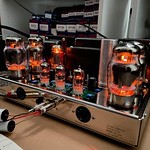Can some kind member suggest what the bias voltage should be?
Thanks in advance.

Dedicated to the restoration and preservation of all original Dynaco tube audio equipment - Customer support for Tubes4hifi VTA tube amp and preamp kits and all Dynakitparts.com products
 KT 88 Bias voltage
KT 88 Bias voltage
 Re: KT 88 Bias voltage
Re: KT 88 Bias voltage Re: KT 88 Bias voltage
Re: KT 88 Bias voltage Re: KT 88 Bias voltage
Re: KT 88 Bias voltageTube Nube wrote:Just replacing a toasted KT 88, now. I've lost my manual.
Can some kind member suggest what the bias voltage should be?
Thanks in advance.
 Re: KT 88 Bias voltage
Re: KT 88 Bias voltageTube Nube wrote:Just replacing a toasted KT 88, now. I've lost my manual.
Can some kind member suggest what the bias voltage should be?
Thanks in advance.

 Re: KT 88 Bias voltage
Re: KT 88 Bias voltageBob Latino wrote:Tube Nube wrote:Just replacing a toasted KT 88, now. I've lost my manual.
Can some kind member suggest what the bias voltage should be?
Thanks in advance.
In a VTA ST-120 the recommended bias voltage is .55 VDC per each output tube. This is a good compromise between long tube life and quality sound in the VTA ST-120. A .40 VDC bias setting per each output tube (IMHO) is just a little too low for a KT88 in the VTA ST-120.
Bob
 Re: KT 88 Bias voltage
Re: KT 88 Bias voltage Re: KT 88 Bias voltage
Re: KT 88 Bias voltage Re: KT 88 Bias voltage
Re: KT 88 Bias voltage Re: KT 88 Bias voltage
Re: KT 88 Bias voltageYou are hereby inducted into the Hall of Shame, if you can withstand resistance for it. Welcome Ohm, Henry.Tube Nube wrote:It was beyond my capacity to resist. Consequently I was induced to commit that pun. Hope it wasn't too much of a battery upon your senses. I could try harder to keep them to myself, but as you know, humour is no fun in a vacuum.
 Re: KT 88 Bias voltage
Re: KT 88 Bias voltage Re: KT 88 Bias voltage
Re: KT 88 Bias voltageWell just don't get wound up about it. We are, after all, bi-polar and quite biased to the Truth, although we are quite Jouley about such matters.Tube Nube wrote:I am truly transformed by this award!
 Re: KT 88 Bias voltage
Re: KT 88 Bias voltage Re: KT 88 Bias voltage
Re: KT 88 Bias voltage Re: KT 88 Bias voltage
Re: KT 88 Bias voltage Re: KT 88 Bias voltage
Re: KT 88 Bias voltage Re: KT 88 Bias voltage
Re: KT 88 Bias voltageAlthough your circuits can get Curly, there is the Larry factor. I just found this essay by Larry about the Wife Acceptance Factor (WAF), and if you don't fall off your chair turn the volume down a bit:Tube Nube wrote:Heheh! THat was too easy for the likes of you!

 Re: KT 88 Bias voltage
Re: KT 88 Bias voltage Re: KT 88 Bias voltage
Re: KT 88 Bias voltage
 Re: KT 88 Bias voltage
Re: KT 88 Bias voltageTube Nube wrote:It was beyond my capacity to resist..

 Re: KT 88 Bias voltage
Re: KT 88 Bias voltagearledgsc wrote:I measured the ST120 plate voltage a week or so ago using a Weber WZ68 rectifier in the amp. I got 490V under load with 119V line voltage. Bob's cathode voltage recommendation for tube current is right in there for 70% plate dissipation of a 35W max. tube like the KT-88. For my setup I actually calculated 0.53v measured across the 10 ohm cathode resistor yields 50mA of plate current. About 5% of the current through the cathode resistor is screen current that is summed with plate current. So 490V x 50mA = 24.5W or 70% of the maximum plate dissipation of 35W.
 Re: KT 88 Bias voltage
Re: KT 88 Bias voltageGP49 wrote:Tube Nube wrote:It was beyond my capacity to resist..
In all seriousness...in all this thread, the role of the cathode RESISTOR has been ignored. There was no mention in the first post of what amplifier was being discussed so we really don't know WHAT it is; it differs among different amplifiers. Some amplifiers use NO cathode resistor...and no matter what, their so-called "bias voltage" (a misnomer, the actual bias voltage is the NEGATIVE voltage applied to the control grid) is zero.
The value of the cathode resistor(s) must be known to provide the desired measurement of the voltage at the cathode. What one is actually adjusting is the cathode CURRENT at idle, which by Ohm's Law results in a voltage at the top of the cathode resistor.
In an amplifier with no cathode resistor, an provision to plug in an ammeter is usually provided, for direct measurement of idle current.

 Re: KT 88 Bias voltage
Re: KT 88 Bias voltageTube Nube wrote:GP49 wrote:Tube Nube wrote:It was beyond my capacity to resist..
In all seriousness...in all this thread, the role of the cathode RESISTOR has been ignored. There was no mention in the first post of what amplifier was being discussed so we really don't know WHAT it is; it differs among different amplifiers. Some amplifiers use NO cathode resistor...and no matter what, their so-called "bias voltage" (a misnomer, the actual bias voltage is the NEGATIVE voltage applied to the control grid) is zero.
The value of the cathode resistor(s) must be known to provide the desired measurement of the voltage at the cathode. What one is actually adjusting is the cathode CURRENT at idle, which by Ohm's Law results in a voltage at the top of the cathode resistor.
In an amplifier with no cathode resistor, an provision to plug in an ammeter is usually provided, for direct measurement of idle current.
I mentioned in a subsequent post that it's the VTA ST-70. I'm guessing that it's the same as the 120, though that's an assumption.